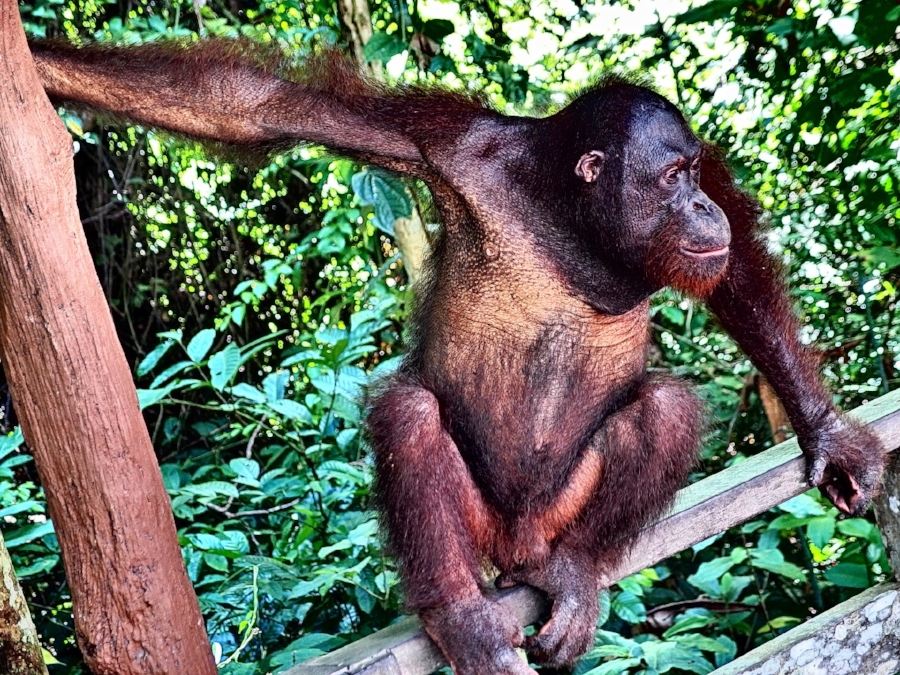The Evolution of Parkour
Parkour sheds light on the evolution of large ape behaviour and tells us that moving efficiently between two points is a twenty-million-year-old survival skill
How do movements like the monkey vault or monkey walk connect us to our primate ancestors?
Yamakasi founding member Sébastian Foucan once remarked that he believed primitive humans had to practice parkour to travel, hunt and escape predators. It turns out that the fundamental parkour skill of moving from point A to point B as quickly and efficiently as possible is even older – by twenty million years.
Traceurs from Parkour Generations joined researchers at the Universities of Birmingham and Roehampton to help answer a mystery that has bamboozled evolutionary scientists for decades: why did large ape species evolve to live in trees when a forest canopy naturally favours smaller creatures?
Despite patchy fossil evidence, some scientists thought it was to do with competition: bigger, more powerful apes could fight off smaller ones in contests for food.
But now it seems the answer lies in an aspect of movement prized by traceurs: efficiency. Greater efficiency of movement reduces energy expenditure in travelling from A to B, which promotes survival, particularly in times of food scarcity.
Our ape ancestors had to deal with these kinds of crises. Those best adapted for efficient movement survived, and passed their genes on to the next generation: a textbook example of Darwin’s theory of evolution by natural selection.
In two recent research studies, Dr Lewis Halsey and colleagues measured traceurs’ oxygen consumption as they performed tasks imitating the movements of arboreal (tree-dwelling) apes. The team of scientists considered that traceurs represented the best available proxy for modelling the movements of large primates like orangutans.
Bridging the gap
The first study tested traceurs’ energy use as they crossed a gap. Direct movement techniques like swaying a flexible pole (similar to how apes bend a tree to reach the next one), or jumping across a space, were much more energy-efficient than climbing down, crossing the floor, and climbing up again.
Measuring the traceurs’ oxygen use allowed the scientists to gauge precisely how much energy was expended – a method not previously applied to model ape movements. (Have you ever tried strapping a VO2 mask to an orangutan?)
Researchers found that levels of energy expenditure for climbing were 10-20 times that of jumping or swaying – much more than previously thought. This is because in climbing, a lot of movement is wasted, and considerable energy is needed to maintain grip and body position.
So, the development of tree-swaying and jumping in ape movement increased energy efficiency. But what about more complex routes?
Don’t touch the ground
The second study measured oxygen consumption as traceurs crossed a 100m assault course without touching the ground. Over four trials the participants significantly cut their time; even one attempt was enough to improve speed.
Though oxygen consumption increased slightly with each trial, this was massively offset by the quicker times. Result: less energy expended with each attempt. And those with longer arm span and shorter legs saw the greatest time improvements and energy savings.
This allowed Halsey and his team to draw two hypotheses. First, that apes with longer arm span and shorter legs could navigate the tree canopy more efficiently, promoting those physical traits. Second, that apes with the cognitive abilities to remember routes and execute complex movements also had the greatest chance of survival in forests.
No surprise that the fossil record shows exactly these kinds of adaptation evolving in primates around twenty million years ago. That lends support to the theory that it was energy efficiency which aided survival for large apes.
Humanlike primates first started walking upright around four million years ago. But the need for our more distant ancestors to navigate the complex forest canopy environment might have laid some foundations for the growth in brain power that distinguished great apes from the rest of nature.
Aping movement
One further interesting observation the researchers made was that traceurs naturally performed several ‘ape’ movements in getting from A to B without being told to do so or shown any film of primates: they simply adapted to the environment to move as efficiently as possible. This included ‘pronograde scrambling’ – moving on all fours with torso parallel to the floor – and ‘brachiation’ – arm-only swinging movement.
So, by using parkour to navigate through the urban environment as efficiently as possible, we engage in behaviour that connects us via twenty million years of evolution to our ape ancestors who lived in trees.
We no longer need parkour to survive, but studying the movements of the sport has given today’s scientists an insight into our ape ancestors. Specifically, how they used those movement skills twenty million years ago to adapt, flourish, and ultimately allow us humans to evolve.
There’s something neat about parkour shedding light on human evolution, thanks to traceurs’ ability to imitate the movements of our ape ancestors.
Getting from A to B efficiently is the essence of parkour. It’s also twenty million years old: think about that the next time you do a monkey vault.
This article appeared on the Parkour Generations website in June 2017 - see it here.

